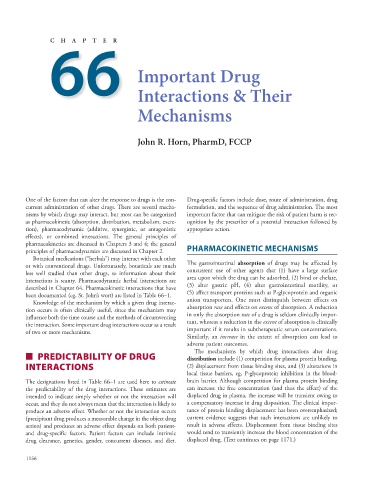Page 1170 - Basic _ Clinical Pharmacology ( PDFDrive )
P. 1170
66 Important Drug
P
C
H
A
T
E
R
Interactions & Their
Mechanisms
John R. Horn, PharmD, FCCP
One of the factors that can alter the response to drugs is the con- Drug-specific factors include dose, route of administration, drug
current administration of other drugs. There are several mecha- formulation, and the sequence of drug administration. The most
nisms by which drugs may interact, but most can be categorized important factor that can mitigate the risk of patient harm is rec-
as pharmacokinetic (absorption, distribution, metabolism, excre- ognition by the prescriber of a potential interaction followed by
tion), pharmacodynamic (additive, synergistic, or antagonistic appropriate action.
effects), or combined interactions. The general principles of
pharmacokinetics are discussed in Chapters 3 and 4; the general
principles of pharmacodynamics are discussed in Chapter 2. PHARMACOKINETIC MECHANISMS
Botanical medications (“herbals”) may interact with each other
or with conventional drugs. Unfortunately, botanicals are much The gastrointestinal absorption of drugs may be affected by
less well studied than other drugs, so information about their concurrent use of other agents that (1) have a large surface
interactions is scanty. Pharmacodynamic herbal interactions are area upon which the drug can be adsorbed, (2) bind or chelate,
described in Chapter 64. Pharmacokinetic interactions that have (3) alter gastric pH, (4) alter gastrointestinal motility, or
been documented (eg, St. John’s wort) are listed in Table 66–1. (5) affect transport proteins such as P-glycoprotein and organic
Knowledge of the mechanism by which a given drug interac- anion transporters. One must distinguish between effects on
tion occurs is often clinically useful, since the mechanism may absorption rate and effects on extent of absorption. A reduction
influence both the time course and the methods of circumventing in only the absorption rate of a drug is seldom clinically impor-
the interaction. Some important drug interactions occur as a result tant, whereas a reduction in the extent of absorption is clinically
of two or more mechanisms. important if it results in subtherapeutic serum concentrations.
Similarly, an increase in the extent of absorption can lead to
adverse patient outcomes.
The mechanisms by which drug interactions alter drug
■ PREDICTABILITY OF DRUG distribution include (1) competition for plasma protein binding,
INTERACTIONS (2) displacement from tissue binding sites, and (3) alterations in
local tissue barriers, eg, P-glycoprotein inhibition in the blood-
The designations listed in Table 66–1 are used here to estimate brain barrier. Although competition for plasma protein binding
the predictability of the drug interactions. These estimates are can increase the free concentration (and thus the effect) of the
intended to indicate simply whether or not the interaction will displaced drug in plasma, the increase will be transient owing to
occur, and they do not always mean that the interaction is likely to a compensatory increase in drug disposition. The clinical impor-
produce an adverse effect. Whether or not the interaction occurs tance of protein binding displacement has been overemphasized;
(precipitant drug produces a measurable change in the object drug current evidence suggests that such interactions are unlikely to
action) and produces an adverse effect depends on both patient- result in adverse effects. Displacement from tissue binding sites
and drug-specific factors. Patient factors can include intrinsic would tend to transiently increase the blood concentration of the
drug clearance, genetics, gender, concurrent diseases, and diet. displaced drug. (Text continues on page 1171.)
1156

